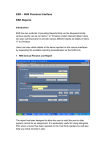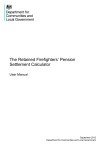Download User guide to the proposed 2015 scheme calculator
Transcript
UNCLASSIFIED User guide to the proposed 2015 scheme calculator The calculator is based on proposals that are subject to change. Results shown by the calculator are estimates, based on the information that you enter. In calculating results, a number of important assumptions are made. These are shown within the calculator. You may find it helpful to have a copy of your latest payslip and annual pension benefit statement to hand. You should receive a statement each year from your pensions administrator. Contents A. Inputting your details - What is your date of birth? - What scheme are you in? - How much nuvos pension have you built up? - How many years would you have built up as of 1 April 2012? Part time - Years of ‘final salary’ service transferred in from other schemes - What are your pensionable earnings? (Full-time rate) - If you work part-time, what fraction of full-time? - See results for retiring at 65, your State Pension Age, and what other age? B. Your results - What pension have you built up so far? - What pension will you get when you retire? - How much will you pay from April 2015? UNCLASSIFIED UNCLASSIFIED Inputting your details 1. What is your date of birth? Ensure that it is the format dd/mm/yy – inputting the incorrect date or no date, will give you incorrect figures. Debbie was born on 13th May 1981 and therefore she should enter 13/05/81into the calculator 2. What scheme are you in? You will be in a scheme called classic, classic plus, premium or nuvos. If you are in Partnership, this calculator is not relevant to you. If you joined the civil service after 30th July 2007 – you will probably be in nuvos. If you joined the civil service between 1 October 2002 and 29th July 2007 you will probably be in premium. You may have also opted to join premium following a choice exercise in 2002. If you joined the civil service before 1 October 2002 you will probably be in the classic scheme. If you were in the classic scheme, you may have opted to move into the classic plus scheme. If you are unsure what scheme you are in, you will find this information on your annual benefit statement. If you have not received a benefit statement, you should contact your HR/Shared services. 2a. How much nuvos pension have you built up? If you are in classic, classic plus or premium, you will not see this question as it is not relevant to your scheme. If you are in nuvos, you will need to input the amount of pension that you have built up so far. The calculator cannot calculate this automatically as it will depend on your individual salary history. UNCLASSIFIED UNCLASSIFIED You will find this information from your last benefit statement. If you have not received one then you should contact your HR/Shared services. 3. How many years will you have built up, as of 1 April 2012? (classic, classic plus and premium scheme only – you will find the nuvos question is below) This is the number of years service that you have built up in the scheme up to 1 April 2012. You will need to enter this as a number. (For example, if you know you have 11 years and 6 months service, you will need to input this as 11.5.) This can also referred to as Reckonable service, and this is where you will see your service on your annual benefit statement. Reckonable service is the service that counts towards your pension. Some service does not count towards your pension for example, unpaid leave and career breaks. If you are part time, the number of years will be reflected by your part time working hours. Please note that your annual benefit statement will be calculated up to a certain point and the one that you should have already received is unlikely to be based on 1 April 2012. Therefore, you should input an approximate number of years that you have worked up until 1 April 2012. If you are full time and your last benefit statement was calculated up to 31st March 2011, you may wish to add a year to the figure to give you approximate results. Alternatively, if you have a number of days to add – you could make the following calculation. Number of days / 365 (number of days in a year) = Proportion of the year worked. As a calculation this is shown as a decimal figure 207 days / 365 = 0.5671 PART TIME If you work part time you will need to input this amount more carefully as your reckonable service will be different to the number of years or months since you joined. An example of what reckonable service should be used is as follows; this technique can be used for classic, classic plus and premium. UNCLASSIFIED UNCLASSIFIED Bob joined the department on 1st July 1999 and is in the classic scheme. Bob worked full time up until 30th June 2009. He then decided to work part time – 30 hours a week instead of 37 hours a week. Bob has received a benefit statement that shows his current service as 11 years 275 days as at 31/03/2011. Bob now needs to work out how much service he needs to put into the calculator to give him an approximate result. The calculation Bob needs to make is: Bob knows he already has 11 years 275 days (up until 31/03/2011) So, from 1/04/2011 – 31/03/2012 = 1 year (full time) To turn this period into part time service Bob will need to do the following calculation. Full time service x number of hours worked / full time contracted hours) 1 x 30/37 = 0.8108 – to turn this decimal into days 0.8108 x 365 (days a year) = 296 days. 11 years 275 days + 296 days = 12 years 206 days (206/365 = 0.5644) = 12 years 206 days = 12.5644 To get approximate results from the calculator Bob could either round up to 13 years or round down to 12 years or you could input the decimal figure of years and days. 3. nuvos members only - Years of ‘final salary’ service transferred in from other schemes. This does not apply to classic, classic plus or premium members If you have not transferred in a fund/pension into the PCSPS, you will not need to consider the following and can leave this question blank. If you have transferred in a fund/pension to the PCSPS from a personal plan or an occupational scheme, this would have been transferred in as final salary and therefore you would have been credited with a number of years service. This will be shown on your annual benefit statement as the number of years and days. You will need to add this into the calculator as a decimal figure. UNCLASSIFIED UNCLASSIFIED If you have transferred in service of 3 years 245 days, this will need to be input as 3.6712. To do this, you will need to make the following calculation: Number of days / number of days in a year = a decimal figure. 245/365 = 0.6712. 3 years 245 days = 3.6712. 4. What are your pensionable earnings? (Full-time rate). Pensionable earnings are used to calculate your benefits and can be made up by your salary and other pensionable elements – not all of your pay will count towards your pension – for example bonus payments do not count. You will be able to find your pensionable earnings in your annual pension benefit statement but if you are unsure you can check your payslip or contact your employer/shared services. You can also input an approximate amount which will provide you with approximate results. 5. If you work part-time, what fraction of full-time? If you currently work full time then, you can to leave this field blank If you currently work part time, you will need to put in your working hours as a decimal figure An example is if you work 3 days out of 5 then you will need to input 0.6. If you work 30 out of 36 hours you will need to put 0.83 to calculate this – 30/36 = 0.83. The following guide may be able to assist you further. 1 day a week = 0.2 15 hr / 37 hr week = 0.41 15 hr / 36 hr week = 0.42 2 days a week = 0.4 20 hr / 37 hr week = 0.54 20 hr / 36 hr week = 0.56 3 days a week = 0.6 25 hr / 37 hr week = 0.68 25 hr / 36 hr week = 0.69 4 days a week = 0.8 32 hr / 37 hr week = 0.86 32 hr / 36 hr week = 0.89 To calculate hours as a decimal = number of hours work / number of full time contracted hours The results that you will get from the calculator will be based on the assumption that you will stay part time, in this capacity, until you retire. UNCLASSIFIED UNCLASSIFIED The calculator cannot currently take into account partial retirement. 6. See results for retiring at 65, your State Pension Age, and what other age? You are able to see results for another age which is between 55 and below State Pension Age. If you are in premium and you are aged 30, you will be able to see results at age 60, at age 68 (which is your State Pension Age) automatically and you will be able to enter another age such as 63. The calculator will know what your current scheme pension age is based on other information you have provided. You can try a number of different ages, which will show you different results. Your results If you are less than 10 years from your current pension age on 1 April 2012, you will remain in your current scheme and therefore no results are shown for the new scheme. However, the calculator will estimate how much pension you will get from your current scheme when you retire. 7. What pension have you built up so far? This set of results will show you how much pension that you up built up, up to 1 April 2012 in your current scheme. classic, classic plus and premium members This amount is based on the figures that you have entered and the pension calculation is based these pensionable earnings. Should you go into the new scheme in 2015, you will build up more final salary service between 2012 and April 2015. Once you leave or retire from the scheme, the pensionable earnings used to calculate your final salary pension will be your salary and any other pensionable allowances at the point of departure. nuvos The amount of pension that has been built up so far, and which you have inputted into your details will be shown. UNCLASSIFIED UNCLASSIFIED 8. What pension you get when you retire Please note that the State Pension Age calculator on http://pensionsservice.direct.gov.uk/en/state-pension-age-calculator/home.asp will show the State Pension Age as it legally stands. The announced change that was made in the Chancellor’s Autumn Statement in November 2011 to increase the State Pension Age for some, has been incorporated into our calculator and therefore the State Pension Age calculator that is available at the link above, may show different results. To find out if you are affected by the announcement, go to http://www.direct.gov.uk/en/Nl1/Newsroom/SpendingReview/DG_192159 Your projected pension is based on the pensionable earnings that you have entered. The projections assume that you continue in the scheme until you reach the age shown. You will see that there are three sets of results based on different pension ages. 1. Pension at current scheme pension age 2. Pension at your State Pension Age 3. Your chosen age (which you would have entered) The figures will show you your combined total pension from both your current scheme and (where applicable) the new 2015 scheme. If you are in classic, classic plus and premium you will see results for a mixture of benefits - It will show you a combined final salary + career average total pension. For those in classic and classic plus, you will see your projected lump sum which is based on your current final salary scheme benefits. Those who are members of nuvos will see a career average projected pension which will be made up of nuvos (career average) + new scheme (career average) scheme. Underneath the projected benefits, are results which show what benefits you would receive if you had continued to build up benefits in your current scheme after 2015. These results show what you would have expected to receive at the current pension age of your current scheme, State Pension Age and at your chosen date. Please note - These are for comparison purposes only. If you are in classic or classic plus, the automatic lump sum is shown. Many people choose to convert some of their pension into a lump sum when they retire. The calculator has assumed that you have taken the same level of lump sum from the new scheme benefits that you have in your current scheme. Therefore your projected pension has been reduced to allow for this conversion. However, in reality, you will have a choice about how much lump sum you want to receive at the point you retire. UNCLASSIFIED UNCLASSIFIED If you are less than 10 years from your current pension age on 1 April 2012, you will remain in the current scheme and therefore, no results will be shown. How much will you pay from April 2015? This figure shows how much you might pay after 2015. It is the total, overall contribution and not the extra amount. Some indicative rates for after 2015 based on your salary have been set but these will be reviewed before they are finalised. Under the Government’s proposals, these rates will apply to everyone, regardless of scheme or your age. The average contribution rate will be 5.6% from 2015. Contributions are deducted from your gross pay before Income Tax is deducted. This gives you tax relief on your contribution ‘at source’. Tax relief has been assumed to apply based on rates at 1 April 2012, to full time pensionable earnings, as follows; Under £45,000 – 20% £45,000 - £150,000 – 40% £150,000 – 45% UNCLASSIFIED















![Mercury Phase 2 Modeller - User guide v8.8.ppt [Compatibility Mode]](http://vs1.manualzilla.com/store/data/006892540_1-e3f28b1bf2a388b24cd40307f49b3ac3-150x150.png)

